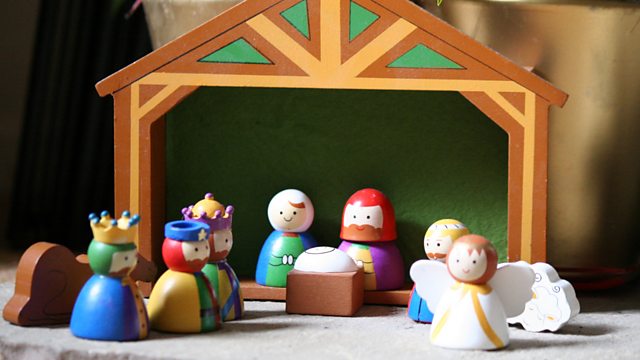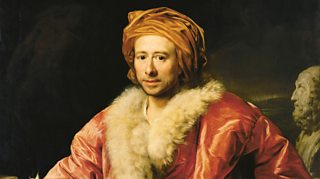Black Magus
"In the face of the Magus I saw a vision of blackness as sanctity: black meaning something good."
In a series exploring the enduring significance of the Nativity story, theologian Robert Beckford reflects on the Magi as a symbol of social inclusion.
Producer: Dan Tierney.
Last on
Script - Black Magus
This year, a new nativity scene manufactured in America, controversially recast all the main characters through the lenses of hipster culture. Hipsters are a diverse subculture of mostly affluent, trendy, young men, best known for sporting beards and causing gentrification. The hipster nativity set, has the three wise men on a Segway, wearing horn-rimmed glasses, and carrying their gifts to baby Jesus in the form of packages from a well-known online retailer. Joseph, the husband of Mary, is sporting a bun hairstyle, and Mary is wearing yoga pants and trendy boots, while taking a selfie with the new-born, as she holds a latte. While the set, which provides a sense of irony and sarcasm, still has all the essential hallmarks of the traditional depiction, for me, it still fails to push the boundaries of the conventional scene.
I am interested in rethinking the nativity so that it challenges dominant ideas, particularly those that lead to marginalisation on grounds of race, class and gender. In other words, can we read the nativity in a way that resists unjust power relations? I want to know if there are symbols that can help us, symbols that we may have missed, especially in relation to the presence of the Magi.
For me, The Magi, commonly referred to as the "three Wise Men" are important for sentimental reasons. As a child, the nativity scene always excited me.�� Not just because its appearance meant the closeness of Christmas presents, but because of the return of the black Magus. Whether in a nativity scene at primary school, or in the front window of a department store, the black Magus was always there as a turban-wearing black man, carrying one of the precious gifts for the baby Jesus. Increasing the pleasure of viewing this man was the fact that in almost every depiction, he was well-dressed in colourful, expensive-looking robes.
The appearance of the black Magus fuelled my fledgling Christian imagination. Over the Christmas season, and in between the hours of church services, and mountains of rice ‘n’ peas and chicken we consumed as a Jamaican family, here was someone I could identify with; a black man showing devotion to Jesus. Nowhere else was such a relationship bequeathed by artists of biblical narratives. On the contrary, the norm I experienced for most of my formative years was the portrayal of all the New Testament characters as white, which made me feel as a black Christian excluded from the story. And they were not just any neutral, everyday sort of white. The Jewishness of these New Testament characters was completely erased, and replaced by a European aesthetic. Jesus was given a classic European makeover.
There is nothing wrong with re-contextualising Jesus as white, say contemporary theologians. However, one should never position one image as the only image, and thereby fail to recognise the theological significance of Jesus’ Jewishness. The importance of a Jewish Jesus is the belief that the incarnation of God in the form of a Jew colonised by the Romans has meaning for the Christian faith as good news for the poor and oppressed. The banality of the white image, led me to believe that everyone, even my devout Jamaican parents, had bought into a domineering European aesthetic, which inadvertently, made the colour black appear bad and white was good.
Countering this whiteness of the New Testament was the black Magus.�� His presence drew me into an alternative reflection. In the face of the Magus I saw a vision of blackness as sanctity: black meaning something good.
Nonetheless, I want to move beyond the sentiment, and search out ways that the Magi’s presence may do more than challenge western Christian iconography. I want to explore how the Magi also signify on issues that confront us today:�� particularly oppressive state power and the marginalisation of minorities and women. I want to start by looking at who the Magi were, according to commentators.
St. Matthew tells the story of the Magi in the second chapter of his gospel.�� The story goes like this:�� after the birth of Jesus in Bethlehem, in the days of Herod the Great, certain Magi from the east travel to Jerusalem.�� They inquire after the new-born king of the Jews, because they have seen his star and they wish to pay him homage.�� Herod hears about this and is troubled. Secretly he attempts to co-opt the Magi into alerting him once they find the child, so that he can also worship him. Or so he tells them.�� After discovering Jesus, the Magi are warned in a dream not to return to see Herod, whose wicked designs become clear to them.��
So, who were the Magi? The word "magi" is derived from Persia, leading some scholars to believe that the Magi were most likely a priestly caste and key figures in Zoroastrianism, an ancient religion of Persia. Their art included ritual healing, the interpretation of dreams, astrology and magic. Matthew introduces them as sages following a star connected to an apocalyptic prophesy. The conventional view is that these men were all foreigners and, gentiles, but given that some Jews also practiced the arts of the Magi, introduces the possibility that not all of Magi were foreigners from Persia. Neither can we be sure that there were only three of them. Because three gifts were offered to the baby Jesus, we commonly assume that three men were present, although none of the gospel writers states this. Neither are they introduced as kings. This interpretation occurs later in Christian history. Furthermore, the masculine plural noun used to describe them (Magoi), does not preclude the presence of women. Of course, this is true of many masculine nouns in Greek; women are included. So, if we accept that the story is historical, as not all scholars do, we are left with the introduction of a group of travelling sages, who are more than likely Zoroastrian priests.
The presence of the Magi in Western theology is deeply symbolic. Eighth-century writers, suggested that each of the Magi represented an ethnic group and their devotion to God. Each was a surrogate of the known world: Asia, Europe and Africa. In Germany, the Magi were especially popular. In the twelfth century, they were first given names:�� Caspar, Melchior, and Balthazar.�� The black figure was named as Balthasar the English monk the Venerable Bede, noted that Balthasar was feared and dressed in a red tunic when he presented his gift of myrrh. By the fifteenth century the convention was normalised and a black Magus is seen in the world of German painters of the period.
Today the primary theological meaning of the Magi is contested.�� Some argue that their presence validates astronomy, and is also an affirmation of multi-faith and inter-faith dialogue at the genesis of the Christian story.�� But a more authoritative theological reading emerges when their account is placed within the context of the role of the gentles in Matthew’s gospel. Matthew understands the meaning of the kingdom of God as encompassing the gentiles. Consequentially, the black Magus represents the gentile world: Africans and their openness to the Christian story.
My childhood hunch was right.�� But is there more at work in the story of the Magi than what the traditional interpretation suggests.
I think that there is more in the message than meets the eye and that the Magi also reflect other elements of the new world order that Jesus ushers in. I think we need to look to the Old Testament to find these hidden meanings.
Some New Testament scholars contend that Matthew is referencing other scriptures to point out themes that he wishes the reader to see in the story. The story of the Magi has some similarities with the story of Balaam in Numbers 22 and the visit of the Queen of Sheba to Jerusalem in 1 Kings 10.
The first story recalls the attempt by a King Balak of Moab to hinder Israel’s access to the Promised Land, a tale not unlike to King Herod’s attempt to thwart the Messiah who would bring salvation to Israel. Balak tries to manipulate the pagan seer Balaam to destroy Israel.�� Similarly, Herod tries to get the Magi to inform on the location of the Messiah. In both cases, the wicked intent of the kings is undermined as both Balaam and the Magi defy prior instructions, and inadvertently become instruments of God's will for the benefit of the masses rather than the elites.
The second story which reminds me of the Magi narrative is the visit of the Queen of Sheba to Jerusalem in 1 Kings 10. In this story, like that of the Magi, a wise foreigner travels to Jerusalem in search of royal wisdom. Like the Magi, the Queen of Sheba, also experiences delight at what is discovered. She offers three gifts for a king: two of which, gold and frankincense, are the same as the Magi’s. Some New Testament scholars go against the grain to argue that Matthew’s parallel of this story opens-up a feminist perspective, which highlights wisdom and a feminine presence in a narrative that has been interpreted to emphasize the role of three men. The argument is twofold.�� First, wisdom is often personified in the feminine in the Old Testament. Perhaps Matthew is subversively playing with the idea that one of the sages is a woman.�� After all, Zoroastrianism permitted female priests.�� Second, it would be inconceivable for Mary, a new mother, to be left alone in the presence of all male guests. The presence of a woman in the entourage would not only have alleviated potential embarrassment, but would account for the unusual overuse of the reference to, “the child and his mother,” which may suggest that there are indeed women present, other than the child and his mother. Scholars suggest that this feminine resonance in the story underscores another counter-cultural reading of the narrative, namely that wise women attended Jesus’ birth. The presence of the women signal the ultimate outsiders- wise women who also have gifts to offer--all of which makes the inclusive message of God's welcoming of outcasts and outsiders, including gentiles and women, into the very heart of the birth of Christianity more comprehensive and radical.��
But do these new insights, whether they are agreed upon or not have anything to offer us in the socially fractious times in which we live?
I think that they do. This current year has been a divisive year in the North Atlantic. The Brexit vote in Britain, and the presidential race in the United States were over-shadowed by negative language of racism and misogyny.�� There has also been a stern rebuke from the United Nations against this toxic political discourse. The impact of the political debate is not academic, but it is visible and palpable at the grassroots level. This is evidenced a spike in reports of racist and sexist assaults - verbal and physical. But for me the Magi narrative is polar opposite to the white, male, nationalist patriarchy which some argue, lies behind the mainstreaming of negative and dangerous views. For in this story, Matthew asserts that the gospel of Jesus is not only opposed to all domineering power structures, but also invites all people, especially the outsiders to play a leading role in an ‘alternative hierarchy,’ where the ‘first are the last and the last are the first.’
��
Broadcast
- Thu 22 Dec 2016 22:45���˿��� Radio 3
Death in Trieste
Watch: My Deaf World
The Book that Changed Me
Five figures from the arts and science introduce books that changed their lives and work.
Podcast
-
![]()
The Essay
Essays from leading writers on arts, history, philosophy, science, religion and beyond.




